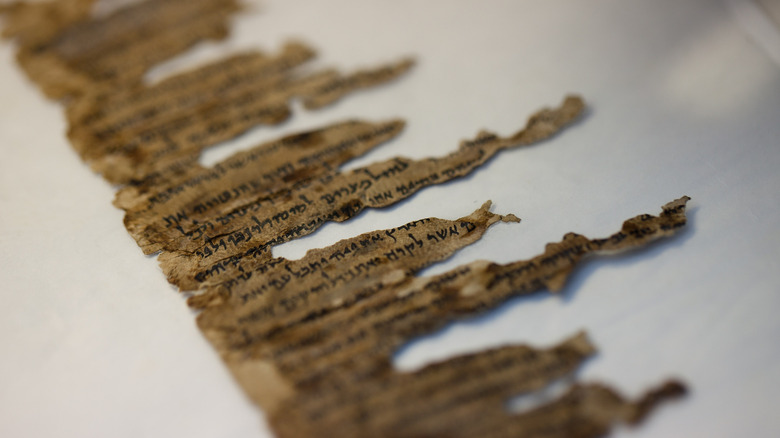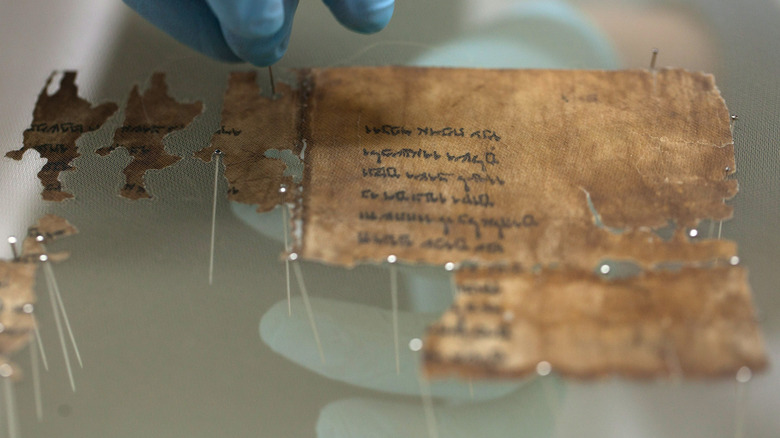Remnants Of A Dead Sea Scroll Showed Up In The Most Unlikely Place
If you were to guess where one of the remnants of the Dead Sea Scrolls was to be found, the state of Montana would probably not be one of them. After all, Judaism developed in the Mesopotamian area, and the Americas remained undiscovered by these people for thousands of more years. So how is it that one of these fragments was found in such an utterly unlikely place?
Technically, it wasn't "discovered" in Montana. The scroll fragment was actually from Israel, but an American woman from Montana got her hands on it in 1965, when she was working with a group of missionaries. The woman remains anonymous. Apparently while the woman was working with fellow missionaries, she also came into contact with people working with the Dead Sea Scrolls and managed to snag her own little piece of the ancient text, according to All That's Interesting. She took it back to her house and framed the small piece, until recently, when the Israel Antiquities Authority asked for it to be returned back to Israel for further study. In 2022 her son returned the fragment to Israel.
What are the Dead Sea Scrolls?
The Dead Sea Scrolls are the oldest copies of the Old Testament that scholars have to this day, but there still is a great deal of debate about their mysterious origin. They were originally found in 1947, in a remote place called Qumran, in the West Bank, according to Smithsonian. The scrolls contain parts of texts from the entire collection of the Hebrew canon, excluding the Book of Esther. The scrolls were presumably written somewhere around 200 B.C., but who put them there and for what reason remains unclear.
One of the most popular stories is that Qumran was home to a group of Jewish scholars, the Essenes, who were known for preserving ancient writings. However, when the Romans ransacked the area the Essenes stashed what we now know as the Dead Sea Scrolls in caves, where the writings wouldn't be discovered for roughly 2,000 years (via Smithsonian).
Some scholars heavily disagree with this interpretation and believe there is no tie between the Essenes and the Dead Sea Scrolls. One theory is that when the Jewish population was being persecuted by the Romans, some Jews hid the scrolls in Qumran, but simply never returned to them, according to Smithsonian. It is most likely that the true story of the scrolls will not be known for a long time, if ever.
What was found in the discovery?
The fragment of the papyrus scroll is one of the oldest remnants of the Dead Sea Scrolls, and it's only one of three to be discovered from the First Temple Period — 970 B.C. to 586 B.C., according to All That's Interesting. The piece is estimated to be around 2,700 years old, written sometime in between the seventh and sixth centuries B.C. The text on the fragment remains elusive, however.
Scholars have been able to make out a few keywords and phrases, such as the fact that the text was addressed to a person named "Ishmael" and contained the phrases "Don't send to ..." and "of no help" (via Newsweek). Professor Shmuel Ahituv of Ben-Gurion University's Department of Bible Studies, Archaeology and the Ancient Near East, the man who tracked down the old text, has been fascinated by the discovery. According to him, the text was written in a hasty manner, and with the purpose still unknown, scholars will have a lot of work on their hands (via All That's Interesting).


